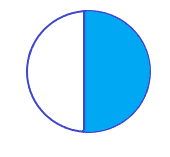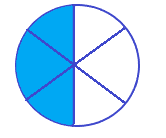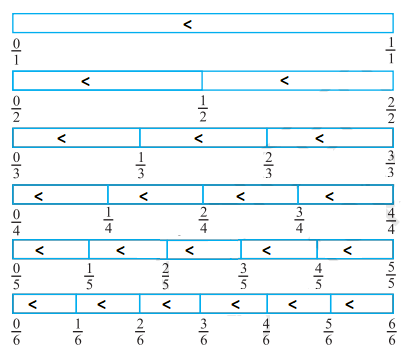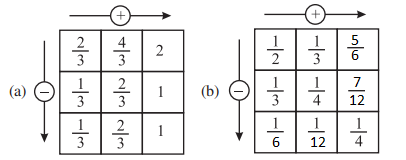NCERT Solutions Class 6 Maths Chapter - 7: FractionsExercise 7.11. Write the fraction representing the shaded portion. i. 
Answer: 2/4 Explanation: Fraction = Shaded number of sections/Total number of sections Shaded number of sections = 2 Total number of sections = 4 Fraction = 2/4 ii. 
Answer: 8/9 Explanation: Fraction = Shaded number of sections/Total number of sections Shaded number of sections = 8 Total number of sections = 9 Fraction = 8/9 iii. 
Answer: 4/8 Explanation: Fraction = Shaded number of balls/Total number of balls Shaded number of balls = 4 Total number of balls = 8 Fraction = 4/8 iv. 
Answer: 1/4 Explanation: Fraction = Shaded number of sections/Total number of sections Shaded number of sections = 1 Total number of sections = 4 Fraction = � v. 
Answer: 3/7 Explanation: Fraction = Shaded number of sections/Total number of sections Shaded number of sections = 3 Total number of sections = 7 Fraction = 3/7 vi. 
Answer: 3/12 Explanation: Fraction = Shaded number of flowers/Total number of flowers Shaded number of flowers = 3 Total number of flowers = 12 Fraction = 3/12 vii. 
Answer: 10/10 Explanation: Fraction = Shaded number of sections/Total number of sections Shaded number of sections = 10 Total number of sections = 10 Fraction = 10 It means that all the sections are shaded. viii. 
Answer: 4/9 Explanation: Fraction = Shaded number of sections/Total number of sections Shaded number of sections = 4 Total number of sections = 9 Fraction = 4/9 ix. 
Answer: 4/8 Explanation: Fraction = Shaded number of sections/Total number of sections Shaded number of sections = 4 Total number of sections = 8 Fraction = 4/8 x. Answer: 1/2 Explanation: Fraction = Shaded number of sections/Total number of sections Shaded number of sections = 1 Total number of sections = 2 Fraction = 1/2 2. Colour the part according to the given fraction. i. 1/6 It means that 1 section is shaded out of total 6 sections. So, here we will shade only one section of the given figure. 
ii. 1/4 It means that 1 section is shaded out of total 4 sections. So, here we will shade only one section of the given figure. 
iii. 1/3 It means that 1 section is shaded out of total 3 sections. So, here we will shade only one section of the given figure. 
iv. 3/4 It means that 3 sections are shaded out of total 4 sections. So, here we will shade only three sections of the given figure. 
v. 4/9 It means that 4 sections are shaded out of total 9 sections. So, here we will shade only four sections of the given figure. 
3. Identify the error, if any. 
All the figures shown above are incorrect. Explanation: Fraction represents shaded portion divided by the total portion. Each portion representing a fraction is of equal dimension. The above three figures has sections of different dimensions, which is incorrect. Thus, we can say that shaded portion in the given figures do not represent a fraction. 4. What fraction of a day is 8 hours? Answer: 8/24 Total hours in a day = 24 So, the value of fraction 8 hours of a day = 8/24 5. What fraction of an hour is 40 minutes? Answer: 40/60 Total minutes in an hour = 60 So, the value of fraction 40 minutes an hour = 40/60 6. Arya, Abhimanyu, and Vivek shared lunch. Arya has brought two sandwiches, one made of vegetable and one of jam. The other two boys forgot to bring their lunch. Arya agreed to share his sandwiches so that each person will have an equal share of each sandwich. (a) How can Arya divide his sandwiches so that each person has an equal share? Answer: Total number of boys = 3 Arya needs to divide each sandwich into three equal parts so that each boy will get equal part of the vegetable and jam sandwich. Fraction = One sandwich/Total number of boys = 1/3 (b) What part of a sandwich will each boy receive? Answer: Total number of sandwiches = 2 Total number of boys = 3 Share of each person = 2/3 Thus, each boy will received 2/3 part of a sandwich. 7. Kanchan dyes dresses. She had to dye 30 dresses. She has so far finished 20 dresses. What fraction of dresses has she finished? Answer: 2/3 Explanation: Total number of dresses = 30 Number of dresses finished by Kanchan = 20 Fraction of dresses she finished = Number of dress finished/ Total number of dresses Fraction = 20/30 Dividing numerator and denominator by 10, we get: Fraction of dresses she finished = 2/3 8. Write the natural numbers from 2 to 12. What fraction of them are prime numbers? Answer: 2, 3, 4, 5, 6, 7, 8, 9, 10, 11, 12; 5/11 Explanation: Natural numbers from 2 to 12 are 2, 3, 4, 5, 6, 7, 8, 9, 10, 11, and 12. Total number of natural numbers from 2 to 12 = 11 Prime numbers between 2 and 12 are 2, 3, 5, 7, and 11 Total number of prime numbers from 2 to 12 = 5 Thus, fraction of prime numbers = Total number of prime numbers from 2 to 12/total number of natural numbers from 2 to 12 = 5/11 9. Write the natural numbers from 102 to 113. What fraction of them are prime numbers? Answer: 102, 103, 104, 105, 106, 107, 108, 109, 110, 111, 112, 113; 4/12 Explanation: Natural numbers from 102 to 113 are 102, 103, 104, 105, 106, 107, 108, 109, 110, 111, 112, and 113. Total number of natural numbers from 102 to 113 = 12 Prime numbers between 102 and 113 are 103, 107, 109, and 113 Total number of prime numbers from 102 to 113 = 4 Thus, fraction of prime numbers = Total number of prime numbers from 102 to 113 /total number of natural numbers from 102 to 113 = 4/12 10. What fraction of these circles has X's in them? 
Answer: 4/8 Explanation: Total number of circles = 8 Number of circles with X = 4 Fraction of circles with X = Number of circles with X/ Total number of circles Fraction of circles with X = 4/8 Dividing numerator and denominator with 4, we get: Fraction of circles with X = ½ Thus, both 4/8 and 1/2 are the answers of the above question. 11. Kristin received a CD player for her birthday. She bought 3 CDs and received 5 others as gifts. What fraction of her total CDs did she buy and what fraction did she receive as gifts. Answer: 3/8, 5/8 Explanation: Number of CDs bought by Kristin for her birthday = 3 Number of CDs received on birthday = 5 Total number of CD = 5 + 3 = 8 Fraction of CDs bought = Number of CDs bought/ Total number of CDs Fraction of CDs bought = 3/8 Fraction of CDs received = Number of CDs received / Total number of CDs Fraction of CDs received = 5/8 Exercise 7.21. Draw number lines and locate the points on the: (a) 1/2, 1/4, 3/4, 4/4 
(b) 1/8, 2/8, 3/8, 7/8 
(c) 2/5, 3/5, 8/5, 4/5 
2. Express the following as mixed fractions: (a) 20 /3 Answer: 6 2/3 Explanation: When 20 is divided by 3 6 × 3 = 18 Remainder = 20 - 18 = 2 Quotient = 6 Mixed fraction = quotient Remainder/divisor Mixed fraction = 6 2/3 (b) 11/ 5 Answer: 2 1/5 Explanation: When 11 is divided by 5 5 × 2 = 10 Remainder = 11 - 10 = 1 Quotient = 2 Mixed fraction = quotient Remainder/divisor Mixed fraction = 2 1/5 (c) 17 /7 Answer: 2 3/7 Explanation: When 17 is divided by 7 7 × 2 = 14 Remainder = 17 - 14 = 3 Quotient = 2 Mixed fraction = quotient Remainder/divisor Mixed fraction = 2 3/7 (d) 28/ 5 Answer: 5 3/5 Explanation: When 28 is divided by 5 5 × 5 = 25 Remainder = 28 - 25 = 3 Quotient = 5 Mixed fraction = quotient Remainder/divisor Mixed fraction = 5 3/5 (e) 19 /6 Answer: 3 1/6 Explanation: When 19 is divided by 6 6 × 3 = 18 Remainder = 19 - 18 = 1 Quotient = 3 Mixed fraction = quotient Remainder/divisor Mixed fraction = 3 1/6 (f) 35/ 9 Answer: 3 8/9 Explanation: When 35 is divided by 9 9 × 3 = 27 Remainder = 35 - 27 = 8 Quotient = 3 Mixed fraction = quotient Remainder/divisor Mixed fraction = 3 8/9 3. Express the following as improper fractions: (a) 7 3/4 Answer: 31/4 Explanation: Improper fraction = Dividend/Divisor Mixed fraction = quotient Remainder/divisor To convert mixed fraction to improper fraction, Improper fraction = (quotient × divisor + remainder) / divisor 7 ¾ = (7 × 4 + 3)/4 = 31/4 (b) 5 6/7 Answer: 41/7 Explanation: Improper fraction = Dividend/Divisor Mixed fraction = quotient Remainder/divisor To convert mixed fraction to improper fraction, Improper fraction = (quotient × divisor + remainder) / divisor 5 6/7= (5 × 7 + 6)/7 = 41/7 (c) 2 5/6 Answer: 17/6 Explanation: Improper fraction = Dividend/Divisor Mixed fraction = quotient Remainder/divisor To convert mixed fraction to improper fraction, Improper fraction = (quotient × divisor + remainder) / divisor 2 5/6 = (2 × 6 + 5)/6 = 17/6 (d) 10 3/5 Answer: 53/5 Explanation: Improper fraction = Dividend/Divisor Mixed fraction = quotient Remainder/divisor To convert mixed fraction to improper fraction, Improper fraction = (quotient × divisor + remainder) / divisor 10 3/5 = (10 × 5 + 3)/5 = 53/5 (e) 9 3/7 Answer: 66/7 Explanation: Improper fraction = Dividend/Divisor Mixed fraction = quotient Remainder/divisor To convert mixed fraction to improper fraction, Improper fraction = (quotient × divisor + remainder) / divisor 9 3/7= (9 × 7 + 3)/7 = 66/7 (f) 8 4/9 Answer: 76/9 Explanation: Improper fraction = Dividend/Divisor Mixed fraction = quotient Remainder/divisor To convert mixed fraction to improper fraction, Improper fraction = (quotient × divisor + remainder) / divisor 8 4/9 = (8 × 9 + 4)/9 = 76/9 Exercise 7.3Write the fractions. Are these all fractions equivalent? a. Answer: 
Fraction = Shaded sections/Total number of sections in a given figure Fraction = 1/2 
Fraction = Shaded sections/Total number of sections in a given figure Fraction = 2/4 Dividing both the numerator and denominator by 2, we get: Fraction = 1/2 
Fraction = Shaded sections/Total number of sections in a given figure Fraction = 3/6 Dividing both the numerator and denominator by 3, we get: Fraction = 1/2 
Fraction = Shaded sections/Total number of sections in a given figure Fraction = 4/8 Dividing both the numerator and denominator by 4, we get: Fraction = 1/2 Thus, we can say that all these fractions are equivalent. b. Answer: 
Fraction = Shaded circles /Total number of circles in a given figure Fraction = 4/12 Dividing both the numerator and denominator by 4, we get: Fraction = 1/3 
Fraction = Shaded circles /Total number of circles in a given figure Fraction = 3/9 Dividing both the numerator and denominator by 3, we get: Fraction = 1/3 
Fraction = Shaded circles /Total number of circles in a given figure Fraction = 2/6 Dividing both the numerator and denominator by 2, we get: Fraction = 1/3 
Fraction = Shaded circles /Total number of circles in a given figure Fraction = 1/3 
Fraction = Shaded circles/Total number of circles in a given figure Fraction = 6/15 Dividing both the numerator and denominator by 3, we get: Fraction = 2/5 Thus, all these fractions are not equivalent because the last fraction is equal to 2/5, while the others are equal to 1/3. 2. Write the fractions and pair up the equivalent fractions from each row. (a) 
Fraction = Shading sections/ Total number of sections in the given figure Shading section = 1 Total number of sections = 2 Fraction = 1/2 (b) 
Fraction = Shading sections/ Total number of sections in the given figure Shading sections = 4 Total number of sections = 6 Fraction = 4/6 Dividing both the numerator and denominator by 2, we get: Fraction = 2/3 It is the fraction in the lowest form, i.e., both the numerator and the denominator has only 1 as the common factor. (c) 
Fraction = Shading sections/ Total number of sections in the given figure Shading sections = 3 Total number of sections = 9 Fraction = 3/9 Dividing both the numerator and denominator by 3, we get: Fraction = 1/3 (d) 
Fraction = Shading sections/ Total number of sections in the given figure Shading sections = 2 Total number of sections = 8 Fraction = 2/8 Dividing both the numerator and denominator by 2, we get: Fraction = 1/4 (e) 
Fraction = Shading sections/ Total number of sections in the given figure Shading sections = 3 Total number of sections = 4 Fraction = 3/4 The above fraction is already present in its lowest form. (i) 
Fraction = Shading triangles/ Total number of triangles in the given figure Shading triangles = 6 Total number of triangles = 18 Fraction = 6/18 Dividing both the numerator and denominator by 6, we get: Fraction = 1/3 (ii) 
Fraction = Shading sections/ Total number of sections in the given figure Shading sections = 4 Total number of sections = 8 Fraction = 4/8 Dividing both the numerator and denominator by 4, we get: Fraction = 1/2 (iii) 
Fraction = Shading sections/ Total number of sections in the given figure Shading sections = 12 Total number of sections = 16 Fraction = 12/16 Dividing both the numerator and denominator by 4, we get: Fraction = 3/4 (iv) 
Fraction = Shading sections/ Total number of sections in the given figure Shading sections = 8 Total number of sections = 12 Fraction = 8/12 Dividing both the numerator and denominator by 4, we get: Fraction = 2/3 (v) 
Fraction = Shading triangles/ Total number of triangles in the given figure Shading triangles = 4 Total number of triangles = 16 Fraction = 4/16 Dividing both the numerator and denominator by 4, we get: Fraction = 1/4 To pair the equivalent fractions, let's represent all the above answers in the form of a table.
Thus, the equivalent fractions are: (a)- (ii) 3. Replace A in each of the following by the correct number: Here we will consider the block as A. (a) 
Answer: 28 Explanation: 2 × A = 8 × 7 Expanding the number 8 2 × A = 2 × 4 × 7 Comparing both sides, we get: A = 4 × 7 A = 28 (b) 
Answer: 16 Explanation: 5 × A = 8 × 10 Expanding the number 10 5 × A = 8 × 2 × 5 5 × A =5 × 8 × 2 Comparing both sides, we get: A = 8 × 2 A = 16 (c) 
Answer: 12 Explanation: 3 × 20 = A × 5 Expanding the number 20 3 × 4 × 5 = A × 5 Comparing both sides, we get: A = 3 × 4 A = 12 (d) 
Answer: 20 Explanation: 45 × A = 60 × 15 Expanding the number 60 45 × A = 3 × 20 × 15 45 × A = 3 × 15 × 20 45 × A = 45 × 20 Comparing both sides, we get: A = 20 (e) 
Answer: 3 Explanation: 18 × 4 = 24 × A Expanding the number 18 6 × 3 × 4 = 24 × A 6 × 4 × 3 = 24 × A 24 × 3 = 24 × A Comparing both sides, we get: A = 3 4. Find the equivalent fraction of 3/5 having (a) denominator 20 Answer: 12/20 Explanation: Let the numerator be A. 3/5 = A/20 3 × 20 = 5 × A Expanding the number 20 3 × 5 × 4 = 5 × A 5 × 4 × 3 = 5 × A 5 × 12 = 5 × A Comparing both sides, we get: A = 12 Fraction = 12/20 Thus, the equivalent value of the fraction is 12/20, where 12 is the numerator and 20 is the denominator. (b) Numerator 9 Answer: 9/15 Explanation: Let the denominator be A. 3/5 = 9/A 3 × A = 5 × 9 Expanding the number 9 3 × A = 5 × 9 3 × A = 5 × 3 × 3 3 × A = 3 × 3 × 5 Comparing both sides, we get: A = 3 × 5 A = 15 Fraction = 9/15 Thus, the equivalent value of the fraction is 9/15, where 9 is the numerator and 15 is the denominator. (c) Denominator 30 Answer: 18/30 Explanation: Let the numerator be A. 3/5 = A/30 3 × 30 = 5 × A Expanding the number 30 3 × 5 × 6 = 5 × A 5 × 6 × 3 = 5 × A 5 × 18 = 5 × A Comparing both sides, we get: A = 18 Fraction = 18/30 Thus, the equivalent value of the fraction is 18/30, where 18 is the numerator and 30 is the denominator. (d) Numerator 27 Answer: 27/45 Explanation: Let the denominator be A. 3/5 = 27/A 3 × A = 5 × 27 Expanding the number 27 3 × A = 5 × 9 3 × A = 5 × 9 × 3 3 × A = 3 × 9 × 5 Comparing both sides, we get: A = 9 × 5 A = 45 Fraction = 27/45 Thus, the equivalent value of the fraction is 27/45, where 27 is the numerator and 45 is the denominator. 5. Find the equivalent fraction of 36/48 with (a) numerator 9 Answer: 9/12 Explanation: Let the denominator be A. 36/48 = 9/A 36 × A = 9 × 48 Expanding the number 48 36 × A = 9 × 12 × 4 36 × A = 9 × 4 × 12 36 × A = 36 × 12 Comparing both sides, we get: A = 12 Fraction = 9/12 Thus, the equivalent value of the fraction is 9/12, where 9 is the numerator and 12 is the denominator. (b) Denominator 4 Answer: 3/4 Explanation: Let the numerator be A. 36/48 = A/4 36 × 4 =48 × A Expanding the number 36 3 × 12 × 4 = 48 × A 12 × 4 × 3 = 48 × A 48 × 3 = 48 × A Comparing both sides, we get: A = 3 Fraction = 3/4 Thus, the equivalent value of the fraction is 3/4, where 3 is the numerator and 4 is the denominator. 6. Check whether the given fractions are equivalent: To check the equivalent fractions, we will convert the fractions to their lowest form, where both the numerator and denominator of a fraction has only 1 as the common factor. (a) 5/9, 30/54 Answer: Yes, the give fractions are equivalent Explanation: 1st Fraction 5/9 is already present in its lowest form. 2nd Fraction Let's consider the second fraction. Factors of 30: 2 × 5 × 3 Factors of 54: 2 × 3 × 3 × 3 Common factors = 2 × 3 = 6 Dividing both the numerator and the denominator of 30/54 by 6, we get: 5/9 Thus, both the fractions are equal. (b) 3/10, 12/50 Answer: No, the give fractions are not equivalent. Explanation: 1st Fraction 3/10 is already present in its lowest form. 2nd Fraction Let's consider the second fraction. Factors of 12: 2 × 2 × 3 Factors of 50: 2 × 5 × 5 Common factor = 2 Dividing both the numerator and the denominator of 12/50 by 2, we get: 6/25 Thus, both the fractions are not equal. 3/10 is not equal to 6/25 (c) 7/13, 5/11 Answer: No, the give fractions are not equivalent Explanation: 1st Fraction 7/13 is already present in its lowest form. 2nd Fraction 5/11 is also present in its lowest form. Thus, both the fractions are not equal. 7. Reduce the following fractions to simplest forms: (a) 48/60 Answer: 4/5 Explanation: Factors of 48: 2 × 2 × 2 × 2 × 3 Factors of 60: 2 × 2 × 3 × 5 Common factors: 2 × 2 × 3 = 12 Dividing both the numerator and the denominator of the given fraction by 12, we get: 4/5 Thus, 4/5 is the simplest form of 48/60. (b) 150/ 60 Answer: 5/2 Explanation: Factors of 150: 3 × 5 × 2 × 5 Factors of 60: 2 × 2 × 3 × 5 Common factors: 2 × 3 × 5 = 30 Dividing both the numerator and the denominator of the given fraction by 30, we get: 5/2 Thus, 5/2 is the simplest form of 150/60. (c) 84/98 Answer: 6/7 Explanation: Factors of 84: 2 × 2 × 7 × 3 Factors of 98: 2 × 7 × 7 Common factors: 2 × 7 = 14 Dividing both the numerator and the denominator of the given fraction by 14, we get: 6/7 Thus, 6/7 is the simplest form of 84/98. (d) 12/52 Answer: 3/13 Explanation: Factors of 12: 2 × 2 × 3 Factors of 52: 2 × 2 × 13 Common factors: 2 × 2 = 4 Dividing both the numerator and the denominator of the given fraction by 4, we get: 3/13 Thus, 3/13 is the simplest form of 12/52. (e) 7/28 Answer: 1/4 Explanation: Factors of 7: 1 × 7 Factors of 28: 2 × 2 × 7 Common factor: 7 Dividing both the numerator and the denominator of the given fraction by 7, we get: 1/4 Thus, 1/4 is the simplest form of 7/28. 8. Ramesh had 20 pencils, Sheelu had 50 pencils and Jamaal had 80 pencils. After 4 months, Ramesh used up 10 pencils, Sheelu used up 25 pencils and Jamaal used up 40 pencils. What fraction did each use up? Check if each has used up an equal fraction of her/his pencils? Answer: 1/2, 1/2, 1/2; Yes Explanation: Total number of pencils with Ramesh = 20 Number of pencils used by Ramesh = 10 Fraction = Used pencils/total pencils Fraction = 10/20 = 1/2 Thus, Ramesh used 1/2 fraction of pencils. Total number of pencils with Sheelu = 50 Number of pencils used by Sheelu = 25 Fraction = Used pencils/total pencils Fraction = 25/50 = 1/2 Thus, Sheelu used 1/2 fraction of pencils. Total number of pencils with Jamaal = 80 Number of pencils used by Jamaal = 40 Fraction = Used pencils/total pencils Fraction = 40/80 = 1/2 Thus, Jamaal also used 1/2 fraction of pencils. Yes, each of them used equal fraction of his/her pencils. 9. Match the equivalent fractions and write two more for each. Here, we will convert the given fraction into its lowest fraction to match with the given values.
Exercise 7.41. Write shaded portion as fraction. Arrange them in ascending and descending order using correct sign between the fractions: (a) Answer: Ascending order: 1/8 < 3/8 < 4/8 < 6/8 Descending order: 6/8 > 4/8 > 3/8 > 1/8 Explanation: 
Number of shaded sections = 3 Total number of sections = 8 Fraction = Shaded sections/Total number of sections Fraction = 3/8 
Number of shaded sections = 6 Total number of sections = 8 Fraction = Shaded sections/Total number of sections Fraction = 6/8 
Number of shaded sections = 4 Total number of sections = 8 Fraction = Shaded sections/Total number of sections Fraction = 4/8 
Number of shaded section = 1 Total number of sections = 8 Fraction = Shaded sections/Total number of sections Fraction = 1/8 To compare the fractions, we need to ensure that the fractions have the same denominator. Ascending order of numbers is the order from smallest fraction to the largest fraction. 1/8 < 3/8 < 4/8 < 6/8 Descending order of numbers is the order from largest fraction to the smallest fractions. 6/8 > 4/8 > 3/8 > 1/8 (b) Answer: Ascending order: 3/9 < 4/9 < 6/9 < 8/9 Descending order: 8/9 > 6/9 > 4/9 > 3/9 Explanation: 
Number of shaded sections = 8 Total number of sections = 9 Fraction = Shaded sections/Total number of sections Fraction = 8/9 
Number of shaded sections = 4 Total number of sections = 9 Fraction = Shaded sections/Total number of sections Fraction = 4/9 
Number of shaded sections = 3 Total number of sections = 9 Fraction = Shaded sections/Total number of sections Fraction = 3/9 
Number of shaded section = 6 Total number of sections = 9 Fraction = Shaded sections/Total number of sections Fraction = 6/9 To compare the fractions, we need to ensure that the fractions have the same denominator. Ascending order of numbers is the order from smallest fraction to the largest fraction. 3/9 > 4/9 > 6/9 > 8/9 Descending order of numbers is the order from largest fraction to the smallest fractions. 8/9 > 6/9 >4/9 > 3/9 (c) Show 2/6, 4/6, 8/6, and 6/6 on the number line. Number line: 
Put appropriate signs between the fractions given. 5/6 > 2/6 Since the denominators of both the fractions are the same, fraction 5/6 is greater than the fraction 2/6. 3/6 > 0 3/6 > 0/6 We can also write 0 as 0/6. Dividing 0 by any number results in 0. Since the denominators of both the fractions are now the same, fraction 3/6 is greater than the fraction 0/6 or 0. 1/6 < 6/6 The fraction 6/6 is greater than the fraction 1/6. 8/6 > 5/6 The fraction 8/6 is greater than the fraction 5/6. 2. Compare the fractions and put an appropriate sign. (a) 3/6 < 5/6 Explanation: The fraction 5/6 is greater than the fraction 3/6 because number 5 is greater than the number 3. (b) 1/7 < 1/4 Explanation: Here, the denominators are different. To compare the fractions, we need the same denominators. So, multiply the left fraction by 4. 1 × 4/ (7 × 4) = 4/28 Similarly, multiply the right fraction by 7. 1 × 7/ (4 × 7) = 7/28 Now, comparing both fractions, 4/28 < 7/28 Hence, 1/7 < 1/4 (c) 4/5 < 5/5 Explanation: The fraction 4/5 is less than the fraction 5/5. (d) 3/5 > 3/7 Explanation: Here, the denominators are different. To compare the fractions, we need the same denominators. So, multiply the left fraction by 7. We can select any multiple to make the denominator of the fractions equal. 3 × 7/ (5 × 7) = 21/35 Similarly, multiply the right fraction by 75 3 × 5/ (7 × 5) = 15/35 Now, comparing both fractions, 21/35 > 15/35 Hence, 3/5 > 3/7 3. Make five more such pairs and put appropriate signs. Answer: Five more such pairs are:
4. Look at the figures and write '<', '>' or '=' between the given pairs of fractions. 
All the numbers above are present in the ascending order. (a) 1/6 < 1/3 To compare, the denominators of the given fractions should be equal. Multiplying the right side fraction by 2, we get: 1 × 2/ (3 × 2) = 2/6 Comparing now, 1/6 < 2/6 Hence, 1/6 < 1/3 (b) 3/4 > 2/6 To compare, the denominators of the given fractions should be equal. Multiplying the left side fraction by 3, we get: 3 × 3/ (4 × 3) = 9/12 Multiplying the right side fraction by 2, we get: 2 × 2/ (6 × 2) = 4/12 Comparing now, 9/12 > 4/12 Hence, 3/4 > 2/6 (c) 2/3 > 2/4 To compare, the denominators of the given fractions should be equal. Multiplying the left side fraction by 4, we get: 2 × 4/ (3 × 4) = 8/12 Multiplying the right side fraction by 3, we get: 2 × 3/ (4 × 3) = 6/12 Comparing now, 8/12 > 6/12 Hence, 2/3 > 2/4 (d) 6/6 = 3/3 A number divided by the same number is always equal to 1. 1 = 1 Hence, 6/6 = 3/3 (e) 5/6 < 5/5 To compare, the denominators of the given fractions should be equal. Multiplying the left side fraction by 5, we get: 5 × 5/ (6 × 5) = 25/30 Multiplying the right side fraction by 3, we get: 2 × 3/ (4 × 3) = 6/12 Comparing now, 8/12 > 6/12 Hence, 2/3 > 2/4 5. How quickly can you do this? Fill appropriate sign. ('<', '>' or '=').. a. 1/2 > 1/5 To compare, the denominators of the given fractions should be equal. Multiplying the left side fraction by 5, we get: 1 × 5/ (2 × 5) = 5/10 Multiplying the right side fraction by 2, we get: 1 × 2/ (5 × 2) = 2/10 Comparing now, 5/10 > 2/10 Hence, 1/2 > 1/5 b. 2/4 = 3/6 To compare, the denominators of the given fractions should be equal. Both the given fractions are not present in their lowest form. So first, we will convert both the fractions to their lowest form. Dividing the left fraction by 2, we get: 1/2 Dividing the right fraction by 3, we get: 1/2 Comparing now, 1/2= 1/2 Hence, 2/4 = 3/6 c. 3/5 < 2/3 To compare, the denominators of the given fractions should be equal. Multiplying the left side fraction by 3, we get: 3 × 3/ (5 × 3) = 9/15 Multiplying the right side fraction by 5, we get: 2 × 5/ (3 × 5) = 10/15 Comparing now, 9/15 < 10/15 Hence, 1/2 > 1/5 3/5 < 2/3 d. 3/4 > 2/8 To compare, the denominators of the given fractions should be equal. The second fraction can be converted to its lowest form. Dividing the right fraction by 2, we get: 1/4 The denominators of both the fractions are now the same. By comparing, 3/4 > 1/4 Thus, 3/4 > 2/8 e. 3/5 < 6/5 The denominators are the same. Thus, 6/5 is greater than 3/5. f. 7/9 > 3/9 The denominators are the same. Thus, 7/9 > 3/9 g. 1/4 = 2/8 To compare, the denominators of the given fractions should be equal. The second fraction can be converted to its lowest form. Dividing the right fraction by 2, we get: 1/4 The denominators of both the fractions are now the same. By comparing, � = 1/4 Thus, 1/4 = 2/8 h. 6/10 < 4/5 To compare, the denominators of the given fractions should be equal. The first fraction can be converted to its lowest form. Dividing the left fraction by 2, we get: 3/5 The denominators of both the fractions are now the same. By comparing, 3/5 < 4/5 Thus, 6/10 < 4/5 i. 3/4 < 7/8 To compare, the denominators of the given fractions should be equal. Multiplying the left side fraction by 2, we get: 3 × 2/ (4 × 2) = 6/8 Comparing now, 6/8 < 7/8 Hence, 3/4 < 7/8 j. 6/10 = 3/5 To compare, the denominators of the given fractions should be equal. The first fraction can be converted to its lowest form. Dividing the left fraction by 2, we get: 3/5 2 × 3 = 6 2 × 5 = 10 The denominators of both the fractions are now the same. By comparing, 3/5 = 3/5 Thus, 6/10 = 3/5 k. 5/7 = 15/21 To compare, the denominators of the given fractions should be equal. The second fraction can be converted to its lowest form. Dividing the right fraction by 3, we get: 5/7 3 × 5 = 15 3 × 7 = 21 The denominators of both the fractions are now the same. By comparing, 5/7 = 5/7 Thus, 5/7 = 15/21 6. The following fractions represent just three different numbers. Separate them into three groups of equivalent fractions, by changing each one to its simplest form. Simplest form refers to the form of a fraction where the numerator and the denominator have only 1 as the common factor. Here, we will find the common multiple and divide the numerator and the denominator with that common multiple. a. 2/12 Answer: 1/6 Explanation: Dividing the numerator and the denominator by 2, we get: 1/6 2 × 1 = 2 2 × 6 = 12 b. 3/15 Answer: 1/5 Explanation: Dividing the numerator and the denominator by 3, we get: 1/5 3 × 1 = 3 3 × 5 = 15 c. 8/50 Answer: 4/25 Explanation: Dividing the numerator and the denominator by 2, we get: 4/25 2 × 4 = 8 2 × 25 = 50 d. 16 /100 Answer: 4/25 Explanation: Dividing the numerator and the denominator by 4, we get: 4/25 4 × 4 = 16 4 × 25 = 100 e. 10/60 Answer: 1/6 Explanation: Dividing the numerator and the denominator by 10, we get: 1/6 10 × 1 = 10 10 × 6 = 60 f. 15/75 Answer: 1/5 Explanation: Dividing the numerator and the denominator by 15, we get: 1/5 15 × 1 = 15 15 × 5 = 75 g. 12/60 Answer: 1/5 Explanation: Dividing the numerator and the denominator by 12, we get: 1/5 12 × 1 = 12 12 × 5 = 60 h. 16/96 Answer: 1/6 Explanation: Dividing the numerator and the denominator by 16, we get: 1/6 16 × 1 = 16 16 × 6 = 96 i. 12/75 Answer: 4/25 Explanation: Dividing the numerator and the denominator by 3, we get: 4/25 3 × 4 = 12 3 × 25 = 75 j. 12/72 Answer: 1/6 Explanation: Dividing the numerator and the denominator by 12, we get: 1/6 12 × 1 = 12 12 × 6 = 72 k. 3/18 Answer: 1/6 Explanation: Dividing the numerator and the denominator by 3, we get: 1/6 3 × 1 = 3 3 × 6 = 18 l. 4/25 The above fraction is already present in its lowest form. The three groups of equivalent fractions are shown in the below table:
7. Find answers to the following. Write and indicate how you solved them. (a) Is 5/9 equal to 4/5? Answer: No Explanation: To compare, the denominators of the given fractions should be equal. Multiplying the left fraction by 5, we get: 5 × 5/ (9 × 5) = 25/45 Multiplying the right fraction by 9, we get: 9 × 4/ (5 × 9) = 36/45 By comparing, 25/45 < 36/45 Thus, 5/9 is not equal to 4/5. (b) Is 9/16 equal to 5/9? Answer: No Explanation: To compare, the denominators of the given fractions should be equal. Multiplying the left fraction by 9, we get: 9 × 9/ (9 × 16) = 81/144 Multiplying the right fraction by 16, we get: 16 × 5/ (16 × 9) = 80/144 By comparing, 81/144 > 80/144 Thus, 9/16 is not equal to 5/9. (c) Is 4/5 equal to 16/20? Answer: Yes Explanation: Let's convert the second fraction to its lowest form. Dividing the numerator and the denominator by 4, we get: (4 × 4)/(4 × 5) = 4/5 By comparing with the first fraction, 4/5 = 4/5 Thus, 4/5 is equal to 16/20. (d) Is 1/15 equal to 4/30? Answer: No Explanation: Let's convert the second fraction to its lowest form. Dividing the numerator and the denominator by 2, we get: (2 × 2)/(2 × 15) = 2/15 By comparing with the first fraction, 1/15 < 2/15 Thus, 1/15 is not equal to 4/30. 8. Ila read 25 pages of a book containing 100 pages. Lalita read 2/5 of the same book. Who read less? Answer: Ila read less Explanation: Number of pages read by Ila = 25 Number of pages read by Lalita = Fraction × Total number of pages = 2/5 × 100 = 200/5 = 40 Number of pages read by Lalita = 40 Thus, Lalita read 40 pages and Ila read 25 pages. 9. Rafiq exercised for 3/6 of an hour, while Rohit exercised for 3/4 of an hour. Who exercised for a longer time? Answer: Rohit exercised for a longer time Explanation: 1 hour = 60 minutes Number of minutes exercised by Rafiq = Fraction × Number of minutes = 3/6 × 60 = 30 minutes Number of minutes exercised by Rohit = Fraction × Number of minutes = 3/4 × 60 = 45 minutes Thus, Rohit exercised for 45 minutes and Rafiq exercised for 30 minutes. 10. In a class A of 25 students, 20 passed with 60% or more marks; in another class B of 30 students, 24 passed with 60% or more marks. In which class was a greater fraction of students getting with 60% or more marks? Answer: Same fraction (4/5) of students got first class in both the classes. Explanation: Number of students in class A = 25 Number of students passed with 60% or more marks in class A = 20 Fraction of passed students = Number of students passed/Total students = 20/25 = 4/5 Fraction of students passed in class A = 4/5 Number of students in class B = 30 Number of students passed with 60% or more marks in class b = 24 Fraction of passed students = Number of students passed/Total students = 24/30 = 4/5 Fraction of students passed in class B = 4/5 Thus, equal fraction of students passed in both the classes. Exercise 7.51. Write these fractions appropriately as additions or subtractions: 
Answer: + (Addition) Explanation: Here, we will first find the value of fraction of each block. 
Fraction = Shaded section/Total number of sections Shaded section = 1 Total number of sections = 5 Fraction = 1/5 
Fraction = Shaded section/Total number of sections Shaded section = 2 Total number of sections = 5 Fraction = 2/5 
Fraction = Shaded section/Total number of sections Shaded section = 3 Total number of sections = 5 Fraction = 3/5 It shows that, 1/5 + 2/5 = 3/5 Thus, it signifies addition. 

Answer: - (Subtraction) Explanation: 
Fraction = Shaded section/Total number of sections Shaded section = 5 Total number of sections = 5 Fraction = 5/5 
Fraction = Shaded section/Total number of sections Shaded section = 3 Total number of sections = 5 Fraction = 3/5 
Fraction = Shaded section/Total number of sections Shaded section = 2 Total number of sections = 5 Fraction = 2/5 It shows that, 5/5 - 3/5 = 2/5 Thus, it signifies subtraction. 

Answer: + (Addition) Explanation: 
Fraction = Shaded section/Total number of sections Shaded section = 2 Total number of sections = 6 Fraction = 2/6 
Fraction = Shaded section/Total number of sections Shaded section = 3 Total number of sections = 6 Fraction = 3/6 
Fraction = Shaded section/Total number of sections Shaded section = 5 Total number of sections = 6 Fraction = 5/6 Thus, 2/6 + 3/6 = 5/6 The above fraction signifies addition. 
2. Solve: (a) 1/18 + 1/18 Answer: 2/18 or 1/9 Explanation: For addition, the denominators should be same. 1/18 + 1/18 = (1 + 1)/18 = 2/18 Both the numerator and the denominator have 2 as the common factor. Let's divide the fraction by 2 to convert to its lowest form. 1/9 2 × 1 = 2 2 × 9 = 18 Thus, 1/18 + 1/18 = 1/9 (b) 8/15 + 3/15 For addition, the denominators should be same. Answer: 11/15 Explanation: 8/15 + 3/15 = (8 + 3)/15 = 11/15 The fraction is already present in its lowest form. 11/15 (c) 7/7 - 5/7 Answer: 2/7 Explanation: 7/7 - 5/7 = (7 - 5)/7 = 2/7 The fraction is already present in its lowest form. 2/7 (d) 1/22 + 21/22 Answer: 1 Explanation: 1/22 + 21/22 = (1 + 21)/22 = 22/22 Both the numerator and the denominator have 22 as the common factor. Let's divide the fraction by 22 to convert to its lowest form. 1/1 22 × 1 = 22 Thus, 1/22 + 21/22 = 1 (e) 12/15 - 7/15 Answer: 5/15 Explanation: 12/15 - 7/15 = (12 - 7)/15 = 5/15 Both the numerator and the denominator have 5 as the common factor. Let's divide the fraction by 5 to convert to its lowest form. 1/3 5 × 1 = 5 5 × 3 = 15 Thus, 12/15 - 7/15 = 1/3 (f) 5/8 + 3/8 Answer: 1 Explanation: 5/8 + 3/8 = (5 + 3)/8 = 8/8 Both the numerator and the denominator have 8 as the common factor. Let's divide the fraction by 8 to convert to its lowest form. 1/1 8 × 1 = 8 Thus, 5/8 + 3/8 = 1 (g) 1 - 2/3 Answer: 1/3 Explanation: 1/1 - 2/3 To subtract, the denominators should be equal. We can write any number with denominator as 1. For example, 1 can be written as 1/1 Multiplying the fraction (1/1) by 3, we get: 3/3 1 × 3/ 1 × 3 = 3/3 Now subtracting, 3/3 - 2/3 = (3 - 2)/3 = 1/3 (h) 1/4 + 0/4 Answer: 1/4 Explanation: 1/4 + 0/4 = (1 + 0)/4 = 1/4 (i) 3 - 12/5 Answer: 3/5 Explanation: To subtract, the denominators should be equal. We can write any number with denominator as 1. For example, 3 can be written as 3/1 Multiplying the fraction (3/1) by 5, we get: 5 × 3/ 1 × 5 = 15/5 Now subtracting, 15/5 - 12/5 = (15 - 12)/5 =3/5 3. Shubham painted 2/3 of the wall space in his room. His sister Madhavi helped and painted 1/3 of the wall space. How much did they paint together? Answer: Fraction of wall painted by Shubham = 2/3 Fraction of wall painted by Madhavi = 1/3 Total wall painted together = 2/3 + 1/3 = (2 + 1)/3 = 3/3 Dividing the numerator and the denominator by 3, we get: 1/1 Thus, Shubham and Madhavi painted together the complete wall. 4. Fill in the missing fractions. (a) 7/10 - 3/10 Answer: 2/5 Explanation: 7/10 - 3/10 = (7 - 3)/10 = 4/10 The numerator and the denominator of the above fraction have 2 as the common factor. Dividing the fraction by 2, we get: 2/5 2 × 2 = 4 2 × 5 = 10 (b) 8/21 ? 3/21 = 5/21 Answer: 8/21 Explanation: Let the blank space be A. A - 3/21 = 5/21 A = 5/21 + 3/21 A = (5 + 3)/21 A = 8/21 = (7 - 3)/10 = 4/10 The numerator and the denominator of the above fraction have 2 as the common factor. Dividing the fraction by 2, we get: 2/5 2 × 2 = 4 2 × 5 = 10 (c) 6/6 - 3/6 = 3/6 Answer: 6/6 Explanation: Let the blank space be A. A - 3/6 = 3/6 A = 3/6 + 3/6 A = (3 + 3)/6 A = 6/6 (d) 7/27 + 5/27 = 12/27 Answer: 7/27 Explanation: Let the blank space be A. A + 5/27 = 12/17 A = 12/27 - 5/27 A = (12 - 5)/27 A = 7/27 5. Javed was given 5/7 of a basket of oranges. What fraction of oranges was left in the basket? Answer: 2/7 The fraction of oranges with Javed = 5/7 Total oranges in the basket = 1/1 The complete fraction is always represented as 1 or 1/1. Fraction of oranges left in the basket = 1/1 - 5/7 To subtract, the denominator should be equal. Multiplying the fraction by 7, we get: (1× 7)/ (1 × 7) = 7/7 Now subtracting, 7/7 - 5/7 = (7 - 5)/7 = 2/7 Thus, 2/7 fraction of oranges was left in the basket. Exercise 7.61. Solve: (a) 2/3 + 1/7 Answer: 17/21 Explanation: To add, the denominators should be equal. So, we will multiply both the fractions by a number to make the denominators equal. 7 × 3 = 21 Multiplying the fraction (2/3) by 7, we get: (2 × 7)/ (3 × 7) = 14/21 Multiplying the fraction (1/7) by 3, we get: (1 × 3)/ (7 × 3) = 3/21 Now, adding = 14/21 + 3/21 = 17/21 We can also convert the fraction to its lowest form. But, the above fraction is already present in its lowest form as the numerator and the denominator has only 1 as the common factor. (b)3/10 + 7/15 Answer: 23/30 Explanation: To add, the denominators should be equal. So, we will multiply both the fractions by a number to make the denominators equal. Multiplying the fraction (3/10) by 3, we get: (3 × 3)/ (10 × 3) = 9/30 Multiplying the fraction (7/15) by 2, we get: (7 × 2)/ (15 × 2) = 14/30 Now, adding = 9/30 + 14/30 = 23/30 (c) 4/9 + 2/7 Answer: 46/63 Explanation: To add, the denominators should be equal. So, we will multiply both the fractions by a number to make the denominators equal. 9 × 7 = 63 Multiplying the fraction (4/9) by 7, we get: (4 × 7)/(9 × 7) = 28/63 Multiplying the fraction (2/7) by 9, we get: (9 × 2)/ (7 × 9) = 18/63 Now, adding = 28/63 + 18/63 = (28 + 18)/63 = 46/63 (d) 5/7 + 1/3 Answer: 22/21 Explanation: To add, the denominators should be equal. So, we will multiply both the fractions by a number to make the denominators equal. 7 × 3 = 21 Multiplying the fraction (5/7) by 3, we get: (5 × 3)/ (3 × 7) = 15/21 Multiplying the fraction (1/3) by 7, we get: (1 × 7)/ (7 × 3) = 7/21 Now, adding = 15/21 + 7/21 = (15 + 7)/21 = 22/21 (e) 2/5 + 1/6 Answer: 17/30 Explanation: To add, the denominators should be equal. So, we will multiply both the fractions by a number to make the denominators equal. 5 × 6 = 30 Multiplying the fraction (2/5) by 6, we get: (2 × 6)/ (5 × 6) = 12/30 Multiplying the fraction (1/6) by 5, we get: (1 × 5)/ (6 × 5) = 5/30 Now, adding = 12/30 + 5/30 = (12 + 5)/30 = 17/30 (f) 4/5 + 2/3 Answer: 22/15 Explanation: To add, the denominators should be equal. So, we will multiply both the fractions by a number to make the denominators equal. 5 × 3 = 15 Multiplying the fraction (4/5) by 3, we get: (4 × 3)/ (3 × 5) = 12/15 Multiplying the fraction (2/3) by 5, we get: (2 × 5)/ (5 × 3) = 10/15 Now, adding = 12/15 + 10/15 = (12 + 10)/15 = 22/15 (g) 3/4 - 1/3 Answer: 5/12 Explanation: To subtract, the denominators should be equal. So, we will multiply both the fractions by a number to make the denominators equal. 4 × 3 = 12 Multiplying the fraction (3/4) by 3, we get: (3 × 3)/ (4 × 3) = 9/12 Multiplying the fraction (1/3) by 4, we get: (1 × 4)/ (4 × 3) = 4/12 Now, subtracting = 9/12 - 4/12 = (9 - 4)/12 = 5/12 (h) 5/6 - 1/3 Answer: 3/6 or 1/2 Explanation: To subtract, the denominators should be equal.. 2 × 3 = 6 Here, we will multiply the fraction (1/3) by 2 to make both the denominators equal. Multiplying the fraction (1/3) by 2, we get: (1 × 2)/ (3 × 2) = 2/6 Now, subtracting, = 5/6 - 2/6 = (5 - 2)/6 = 3/6 Let's divide the above fraction by 2 to convert to its lowest form. 1/2 3 × 1 = 3 3 × 2 = 6 (i) 2/3 + 3/4 + 1/2 Answer: 23/12 Explanation: To add, the denominators should be equal. To make the denominators equal, we will find the LCM of all the denominators. LCM (3, 4, 2) = 12 So, we will multiply the three fractions by a number to make the denominators equal to 12. Multiplying the fraction (2/3) by 4, we get: (2 × 4)/ (3 × 4) = 8/12 Multiplying the fraction (3/4) by 3, we get: (3 × 3)/ (4 × 3) = 9/12 Multiplying the fraction (1/2) by 6, we get: (1 × 6)/ (2 × 6) = 6/12 Now, adding 8/12 + 9/12 + 6/12 = (8 + 9 + 6)/12 = 23/12 (j)1/2 + 1/3 + 1/6 Answer: 6/6 or 1 Explanation: To add, the denominators should be equal. To make the denominators equal, we will find the LCM of all the denominators. LCM (2, 3, 6) = 6 So, we will multiply the three fractions by a number to make the denominators equal to 6. Multiplying the fraction (1/2) by 3, we get: (1 × 3)/ (2 × 3) = 3/6 Multiplying the fraction (1/3) by 2, we get: (1 × 2)/ (3 × 2) = 2/6 The third fraction has already 6 as the denominator. Now, adding 3/6 + 2/6 + 1/6 = (3 + 2 + 1)/6 = 6/6 Dividing the above fraction by 6, we get: 1/1 or 1 (k) 1 1/3 + 3 2/3 Answer: 5 Explanation: The fractions and the whole parts can be added separately. (1 + 3) + (1/3 + 2/3) = 4 + (3/3) = 4 + 1 = 5 (l) 4 2/3 + 3 1/4 Answer: 95/12 Explanation: The fractions and the whole parts can be added separately. Whole part (4 + 3) = 7 Fraction part 2/3 + 1/4 To add, the denominator of the fraction should be equal to 12. 3 × 4 = 12 Multiplying the fraction (2/3) by 4, we get: (2 × 4)/ (3 × 4) = 8/12 Multiplying the fraction (1/4) by 3, we get: (1 × 3)/ (4 × 3) = 3/12 Adding now, 8/12 + 3/12 = (8 + 3)/12 = 11/12 Let's add fraction part and whole part, 7 + 11/12 7/1 + 11/12 Multiplying the fraction (7/1) by 12, we get: 7 × 12/ 1 × 12 = 84/12 Adding now, 84/12 + 11/12 = 95/12 (m) 16/5 - 7/5 Answer: 9/5 Explanation: = 16/5 - 7/5 = (16 - 7)/5 = 9/5 (n) 4/3 - 1/2 Answer: 5/6 Explanation: To subtract, the denominators should be equal. To make the denominators equal, we will find the LCM of all the denominators. LCM (3, 2) = 6 So, we will multiply the two fractions by a number to make the denominators equal to 6. Multiplying the fraction (4/3) by 2, we get: (2 × 4)/ (3 × 2) = 8/6 Multiplying the fraction (1/2) by 3, we get: (1 × 3)/ (2 × 3) = 3/6 Now subtracting, 8/6 - 3/6 = (8 - 3)/6 = 5/6 2. Sarita bought 2/5 metre of ribbon and Lalita 3/4 metre of ribbon. What is the total length of the ribbon they bought? Answer: 23/20 Length of ribbon bought by Sarita = 2/5 meter Length of ribbon bought by Lalita =3/4 meter Total length = Length bought by Sarita + Length bought by Lalita = 2/5 + 3/4 Let's multiply the fraction (2/5) by 4 and the fraction (3/4) by 5 to make the denominators equal to 20. (2 × 4)/ (5 × 4) = 8/20 (3 × 5)/ (4 × 5) = 15/20 Total length = 8/20 + 15/20 = 23/20 Thus, Sarita and Lalita bought together 23/20 meter of the ribbon. 3. Naina was given 1 1/2 piece of cake and Najma was given 1 1/3 piece of cake. Find the total amount of cake was given to both of them. Answer: Piece of cake given to Naina = 1 1/2 Piece of cake given to Najma = 1 1/3 Total amount of cake = 1 1/2 + 1 1/3 Let's add whole and fraction part separately, we get: (1 + 1) + (1/2 + 1/3) Multiplying the fraction (1/2) by 3 and the fraction (1/3) by 2, we get: 2 + ((1 × 3)/(2 × 3) + (1 × 2)/ (3 × 2)) = 2 + (3/6 + 2/6) = 2 + 5/6 = 2 5/6 Thus, the total amount of cake was given to both of them is2 5/6. 4. Fill in the boxes: 
Answer: 7/8 Explanation: Let the blank space be A. A - 5/8 = 1/4 A = 1/4 + 5/8 Multiplying the fraction (1/4) by 2, we get: (1 × 2)/ (4 × 2) = 2/8 Adding now, A = 2/8 + 5/8 A = 7/8 
Answer: 7/10 Explanation: Let the blank space be A. A - 1/5 = 1/2 The negative sign becomes positive when taken on the other side. A = 1/2 + 1/5 Multiplying the fraction (1/2) by 5 and the fraction (1/5) by 2 to make the denominator equal to 10, we get: A = 5/10 + 2/10 A = (5 + 2)/10 A = 7/10 
Answer: 1/3 Explanation: Let the blank space be A. 1/2 - A = 1/6 A = 1/2 - 1/6 Multiplying the fraction (1/2) by 3, we get: A = 3/6 - 1/6 A = (3 - 1)/6 A = 2/6 Dividing the numerator and the denominator by the common factor (2), we get: A = 1/3 5. Complete the addition-subtraction box. 
6. A piece of wire 7/8 metre long broke into two pieces. One piece was 1/4 metre long. How long is the other piece? Answer: 5/8 m Total length of the wire = 7/8 meter Length of one piece = 1/4 meter Length of the other piece = Total length - Length of one piece = 7/8 - 1/4 Multiplying the fraction (1/4) by 2, we get: = 7/8 - 2/8 = (7 - 2)/8 = 5/8 Thus, the length of the other piece is 5/8 meter. 7. Nandini's house is 9/10 km from her school. She walked some distance and then took a bus for 1/2 km to reach the school. How far did she walk? Answer: 2/5 km or 4/10 km Total distance of the Nandini's house from her school = 9/10 km Distance taken by a bus = 1/2 km Distance Nandini walked = 9/10 - 1/2 Multiplying the second fraction by 5, we get: 9/10 - 5/10 = (9 - 5)/10 = 4/10 Dividing the above fraction by 2, = 2/5 Thus, Nandini walked 2/5 km to reach the school. 8. Asha and Samuel have bookshelves of the same size partly filled with books. Asha's shelf is 5/6th full and Samuel's shelf is 2/5th full. Whose bookshelf is more full? By what fraction? Answer: Asha; 13/30 The fraction of Asha's shelf filled with books = 5/6th The fraction of Samuel's shelf filled with books = 2/5th To compare, let's make their denominators equal. Multiplying the fraction (5/6) by 5, we get: (5 × 5)/ (6 × 5) = 25/30 Multiplying the fraction (2/5) by 6, we get: (2 × 6)/ (5 × 6) = 12/30 By comparing, 25/30 > 12/30 Thus, Asha's book shelf is fuller than the Samuels' book shelf. Difference = 25/30 - 12/30 = (25 - 12)/30 = 13/30 Thus, Asha's book shelf is fuller than the Samuels' book shelf by 13/30. 9. Jaidev takes 2 1/5 minutes to walk across the school ground. Rahul takes 7/4 minutes to do the same. Who takes less time and by what fraction? Answer: Rahul; 9/20 minutes Time taken by Jaidev to walk across the school ground = 2 1/5 = 11/5 Time taken by Rahul to walk across the school ground = 7/4 Multiplying the fraction (11/5) by 4, we get: (11 × 4)/ (5 × 4) = 44/20 Multiplying the fraction (7/4) by 5, we get: (7 × 5)/ (4 × 5) = 35/20 By comparing, 35/20 < 44/20 Thus, Rahul takes less time. Difference = 44/20 - 35/20 = (44 - 35)/20 = 9/20 Rahul takes 9/20 minutes less than the Jaidev.
Next TopicClass 6 Maths Chapter 8
|
 For Videos Join Our Youtube Channel: Join Now
For Videos Join Our Youtube Channel: Join Now
Feedback
- Send your Feedback to [email protected]
Help Others, Please Share










